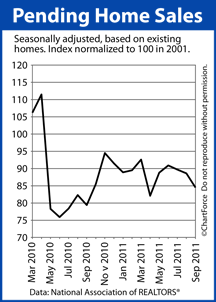 Nationwide, fewer homes are going under contract to sell.
Nationwide, fewer homes are going under contract to sell.
According to the National Association of REALTORS®, the Pending Home Sales Index fell 5 percent last month. September marks the fourth consecutive month in which the index has dropped.
The Pending Home Sales Index is a monthly index which measures the number of homes under contract to sell, but not yet closed. As such, it’s among the few “forward-looking” housing indicators; a data set meant to predict future home sales.
80% of homes under contract close within 2 months so, if the September Pending Home Sales Index is to be believed, we should expect home sales to decline through October and November.
And that’s before we account for cancelled contracts.
Also from the National Association of REALTORS®, we learn that 18 percent of homes under contract failed to close in September. This is double the failure rate from September 2010 and it, too, should drag Existing Home Sales volume lower this fall.
On a seasonally-adjusted, regional basis, the Pending Home Sales Index fell everywhere.
- Northeast Region: -4.7% from August
- Midwest Region : -6.2% from August
- South Region : -5.5% from August
- West Region : -2.1% from August
For home buyers and sellers in Minneapolis and St Paul , though, regional data remains too broad to be useful. Housing markets are local, meaning that each block on each street on each city has its own distinct economy. When 9 states are grouped into a single “region”, it’s neither helpful nor relevant to people making buy/sell decisions.
That said, the Pending Home Sales Index remains important because it’s about housing, and housing is a keystone of the U.S. economic recovery.
The market looks ideal for buyers. Home prices are rising, but slowly; and mortgage rates remain near rock-bottom levels. Home affordability is high and should remain that way for the next few weeks.
If you’re shopping for a home, it’s an excellent time to go under contract.
 Home builders continue to sell homes and work through inventory.
Home builders continue to sell homes and work through inventory.